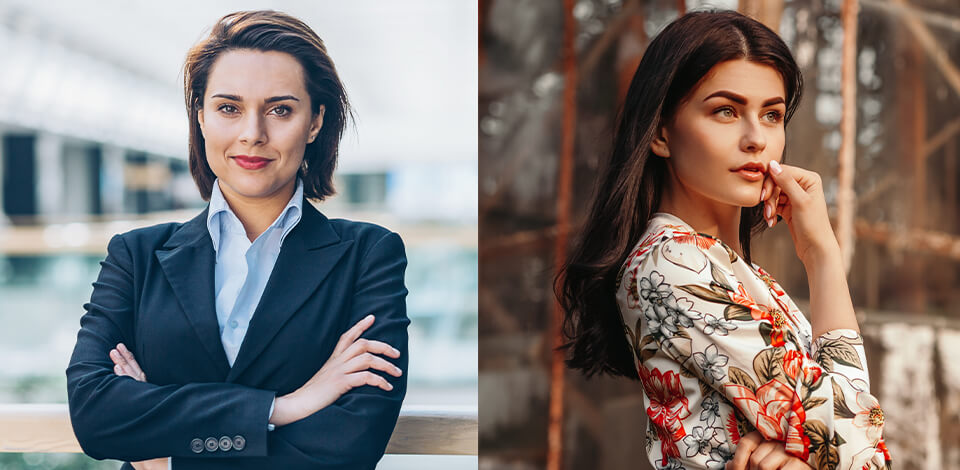
A lot of amateurs treat the terms professional headshot and portrait photography as interchangeable. However, the first distinction is the purpose behind the photo.
Ordinarily, headshots are meant exclusively for official business use while portraits are more artistic and are often taken to tell a story about a person.
If one of your clients asks for a headshot or portrait, clarify if their expectations are in line with what they have asked for. Dive deeper into the differences between portrait and headshot photography to ensure your clients get exactly what they ask for.

A headshot is composed specifically to only include the head and shoulders of the subject. All of the emphasis is placed on the face, with the photographers sometimes resorting to cropping in photography to achieve the desired result.
Headshots can occasionally include the upper body of the person as well but the focus should remain on the face since otherwise, it isn't a headshot anymore but rather a 3/4 portrait. On the other side, you have portraits that can be composed in any way you see fit: full body, waist-up, or just the face.
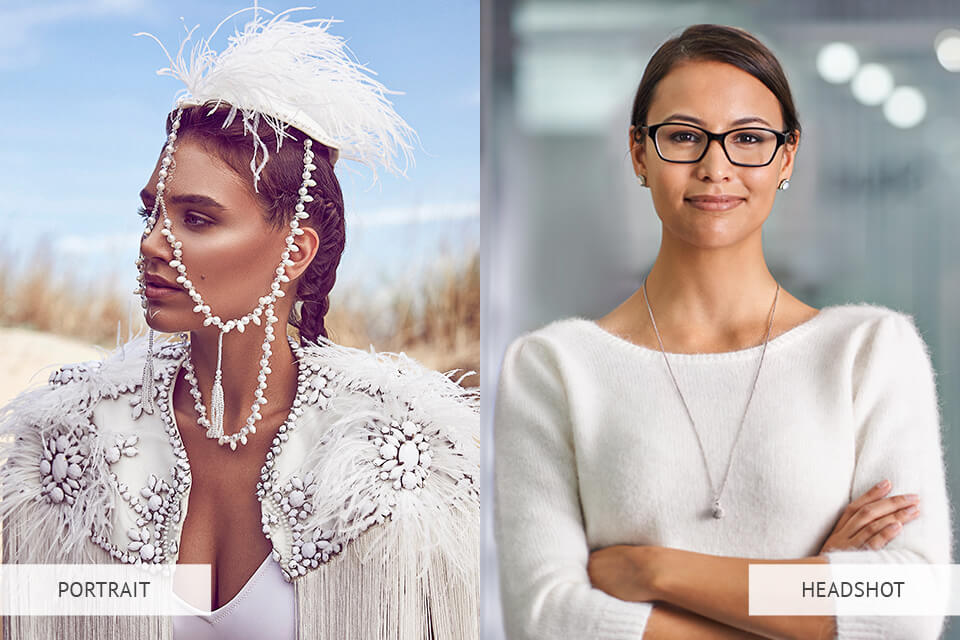
The second key difference between headshot and portrait photos is the creative “license” that comes with the latter. While not a strict rule, creative photos can rarely be called headshots since those usually look rather generic and standardized.
Meanwhile, portraits provide more room for creativity and personality and this is particularly true for fine art portrait photography.
Portrait photographers can try out different lighting setups, interesting poses, unique color combinations, props, flashy attires, unusual angles, backgrounds, and thousands of creative portrait photography ideas.
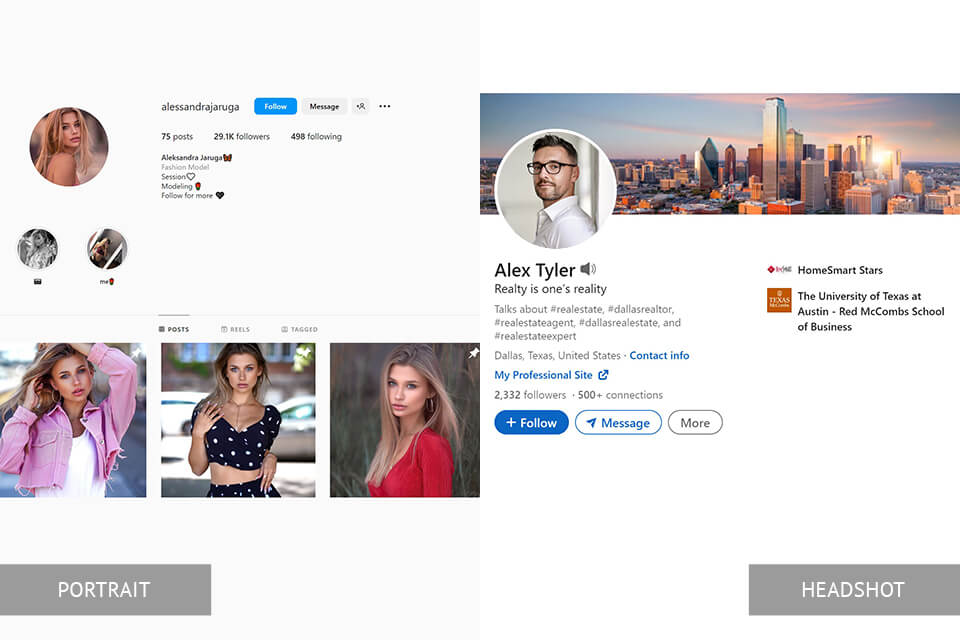
Headshots are almost exclusively used for professional purposes that require a formal photo. The headshot usually formally represents an employee in the business world. Businesspersons take headshots to later feature them in their professional profiles and relevant articles.
Meanwhile, actors and models have to ensure they have a recent, professional headshot, as it’s the first thing casting directors and recruiters see when opening their portfolio. Moreover, due to the ever-rising popularity of LinkedIn and other similar platforms, nearly everyone can benefit from a quality headshot nowadays.
Meanwhile, a portrait is ordinarily far more informal and creative, as it’s often used to highlight the personality of the subject or to tell a story. Portrait photos are frequently employed for personal and editorial projects and can often be found in magazine articles, press releases, and various ads.
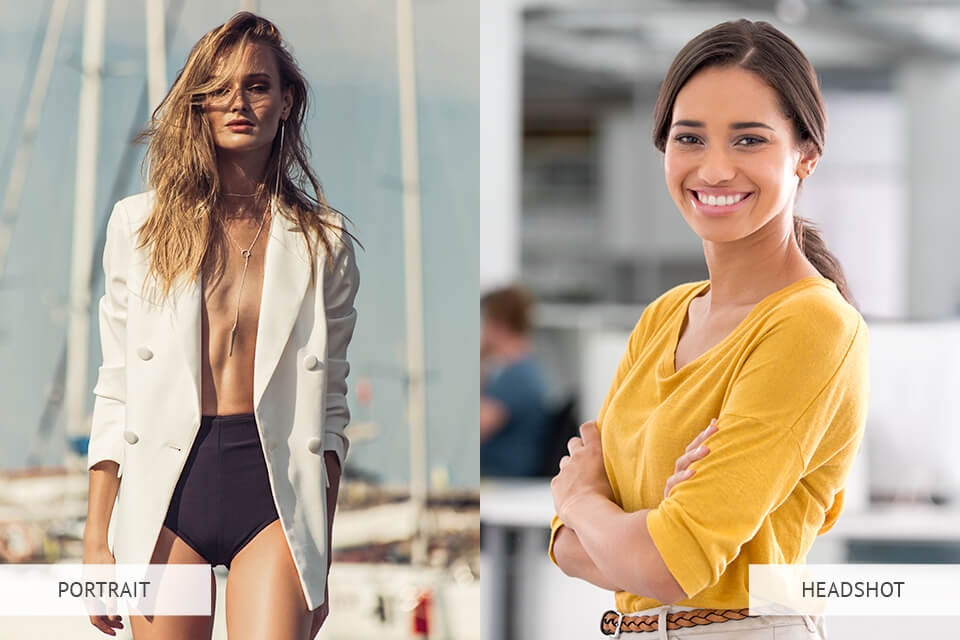
The main goal of a good headshot is to focus the viewer’s entire attention on the model’s face. That’s why most headshot background ideas don’t go any further than a neutral, clean studio backdrop.
If headshot photos are taken in a different setting, they typically have a blurry backdrop. As such, the viewer won’t be distracted by any irrelevant details.
Portraiture utilizes backdrops to enrichen the shot. The scenery can play an important part in the overall composition if the photographer thinks it can help convey the desired mood or message. This explains why outdoor portrait photography is such a popular genre.
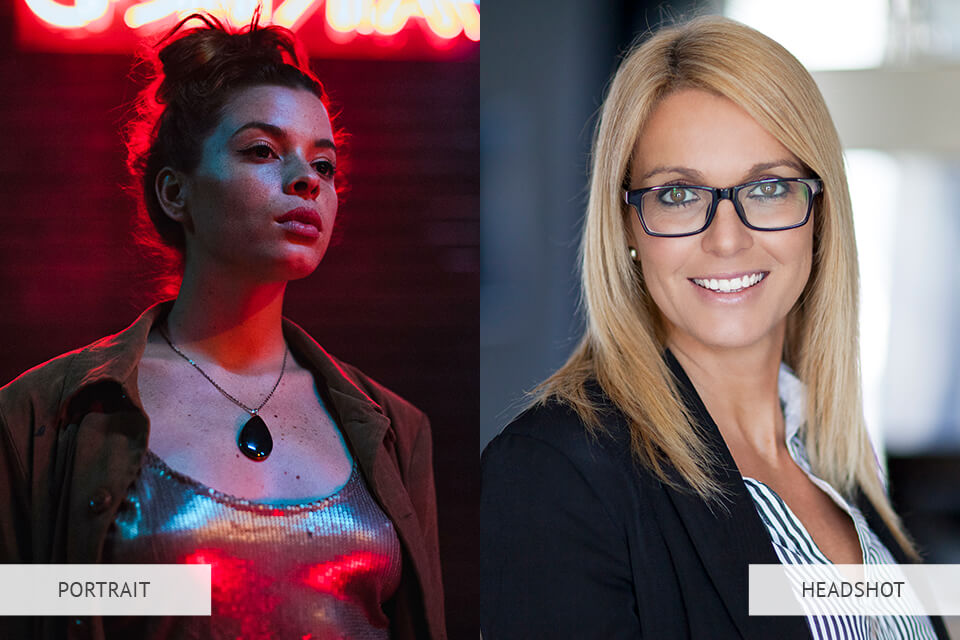
Proper lighting is essential for professional headshots, which is why they are typically taken in a studio that has access to a complete studio lighting kit, including strobe lights for photography and continuous lights. Ideally, you want to shed a broad, soft, evenly spread light onto the subject while ensuring the entire face is properly lit.
In contrast to headshots, portraiture frequently relies on more impactful lights, like Rembrandt lighting in photography. Such lighting does wonders for infusing the photo with an artistic feel. If you want to make your lighting setup even more creative, you can experiment with different items like mirrors, glass, and color gels.
Due to the versatility of the portrait genre, the created lighting can range from neutral, evenly-spread light to dramatic, attention-grabbing setups.
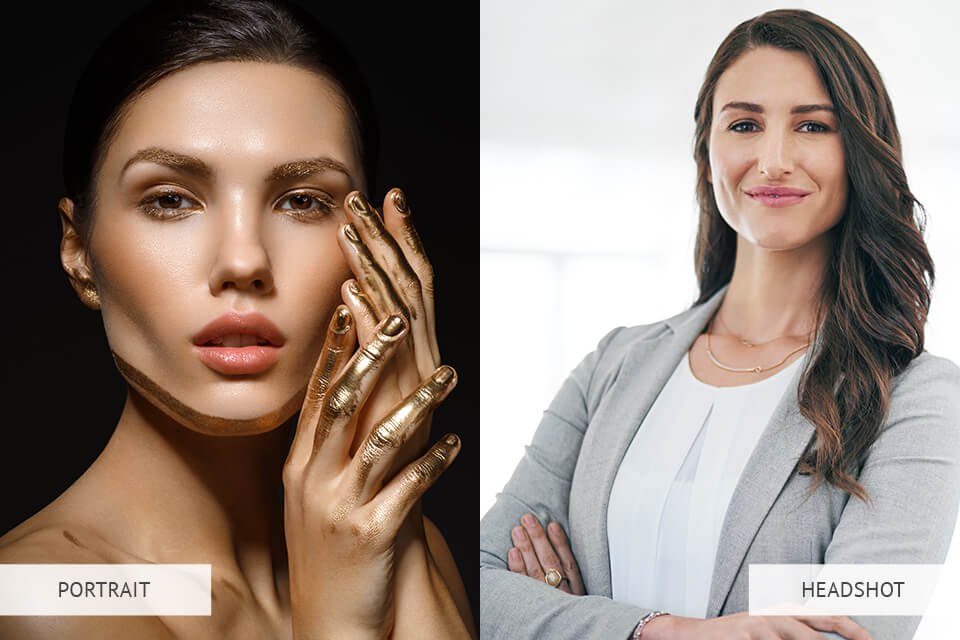
In a normal headshot, the person looks “stiff”, gazes straight at the camera, and has a neutral, restrained facial expression. Good headshot poses emphasize the subject's most appealing facial features while diverting attention from possible flaws like a double chin.
Portrait photography poses offer a lot more variety and pertain to the entire body, as sometimes even purposefully awkward poses can look great when used for a fashion photoshoot. Pick a pose that helps convey the desired message or highlight a specific character trait of the model.
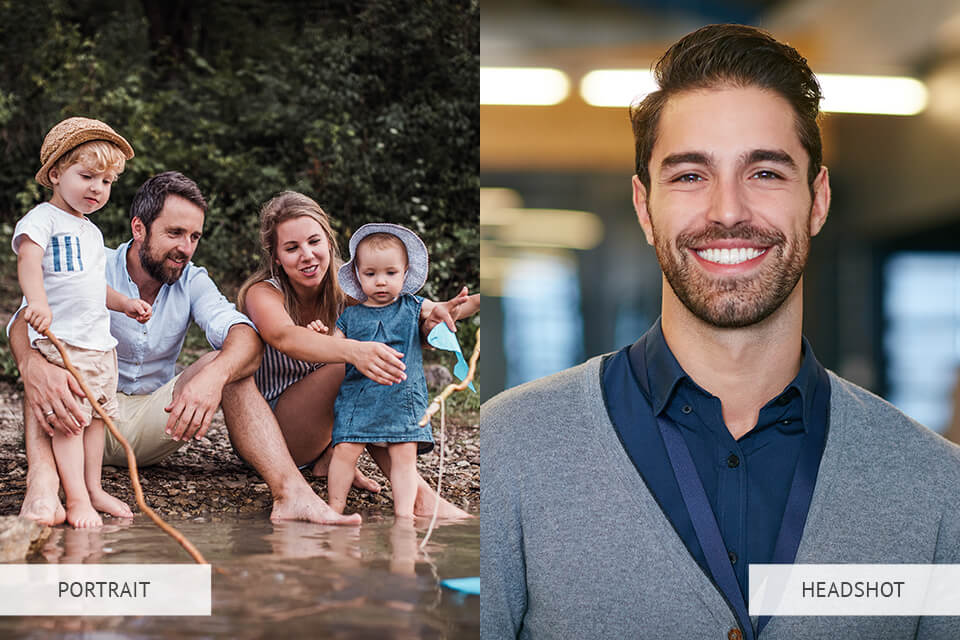
Headshots typically only feature a single person while portrait photos can include as many individuals as you want. As such, when comparing headshots and portraits, remember that the former always focuses on the solo subject while the latter isn't limited by such a restriction.
Even though individual portraits are the most popular type, there’s no shortage of group or family portrait photos as well and even pictures that include an entire class of students, sports team, or all the wedding guests also count as portraits.
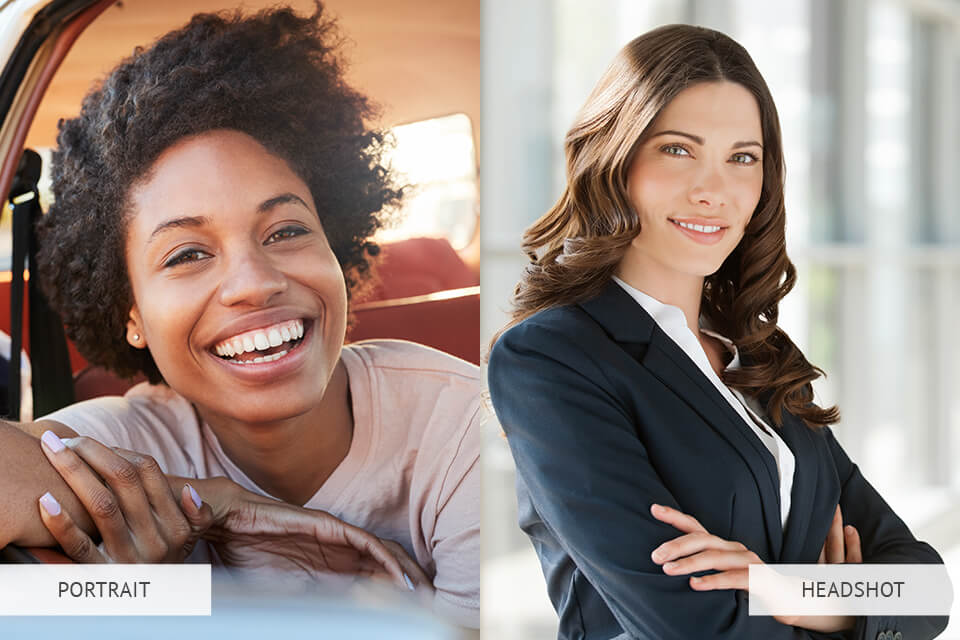
Professional headshot photographers usually aim to establish a relaxed and friendly mood for the photos and frequently ask the subject to smile to ensure the headshot makes them come across as trustworthy, positive, and approachable.
The aforementioned description is particularly relevant for people who need a profile picture for their LinkedIn page or business site. That said, other clients may want the headshot to look even more professional while conveying concentration, power, wisdom, and so on.
Meanwhile, portraiture isn’t as restricted in its range of depicted moods, as you can change the atmosphere and displayed emotions freely to get the desired message across. Regardless of whether you take a dark, moody picture with a gloomy backlight or an extremely bright photo with an abundance of natural light filling the scene – anything goes as long as the portrait tells the story your client wants to tell.
The decision between smiling and not smiling is entirely up to you and what kind of mood you want to convey. If you’re going to smile, you’ll come across as more friendly and trustworthy, which is the better call in most situations. However, if you want to create a more serious, no-nonsense impression, then “no smile” is the way to go.
If a photo features your entire body, it isn’t a headshot anymore since the latter has to be focused on the subject’s head and shoulders or at the very least not go lower than the elbow line.
There’s no strict rule in this regard since both portrait and landscape orientation will do as long as the photo includes the head and shoulders of the subject. One recommendation you should follow is framing the shot in a way that will later allow you to crop the photo into a square so that the client later has more options when adding their headshot to different platforms that may require vertical or horizontal images.
You can’t go wrong with solid and neutral tones since they allow the viewer to focus entirely on the subject. The most popular tones of this kind are white, cream, navy, and black since they all look visually pleasing without drawing attention to themselves.
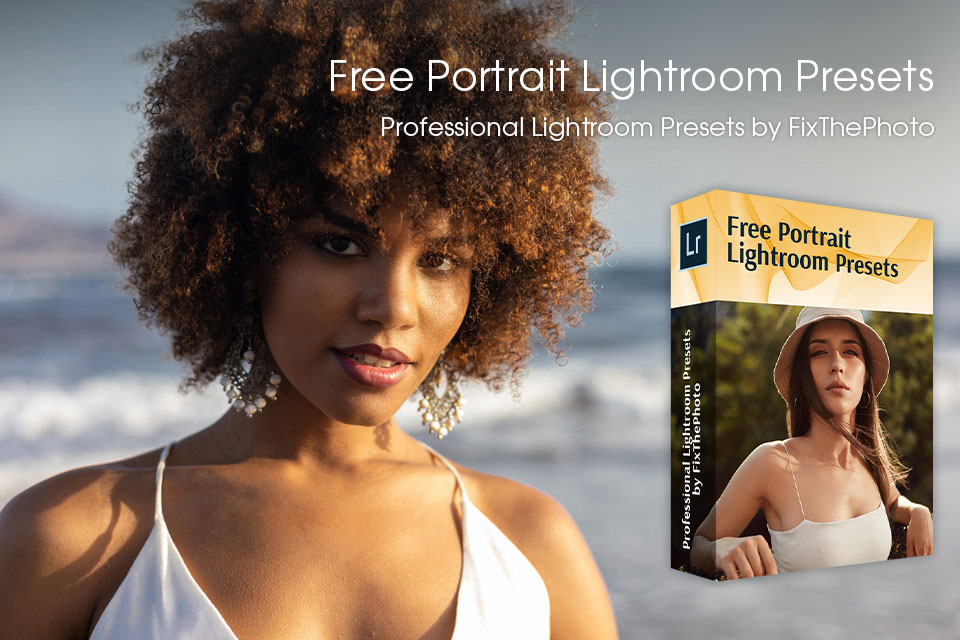
Enhance the quality of your portrait and headshot photos in just a few seconds with the help of these premade filters. They perform an array of adjustments that are perfect for both outdoor and indoor portraits, as these tools enhance the colors, fix the exposure, and make the overall feel of the photo more stylish.